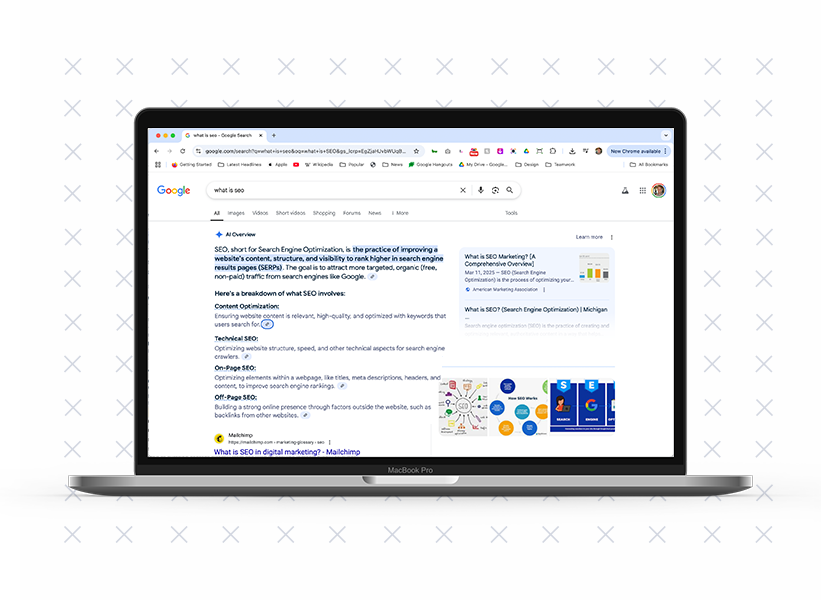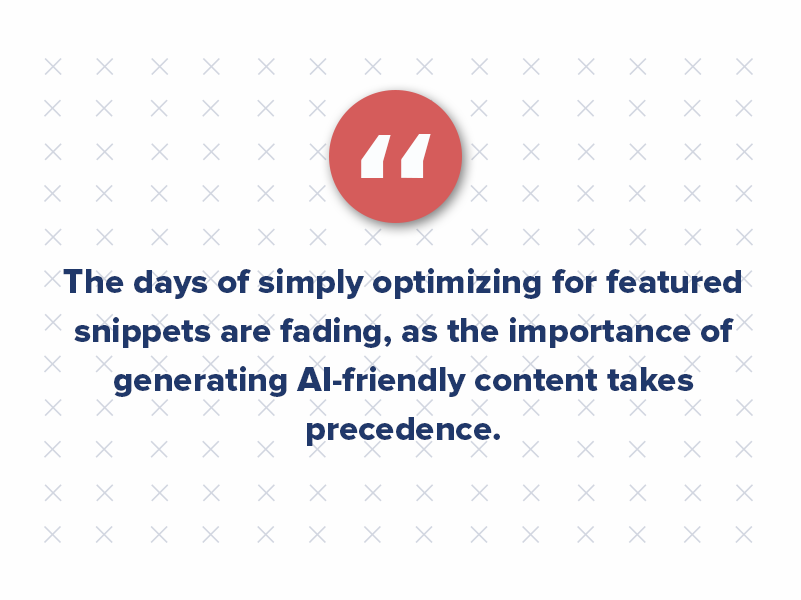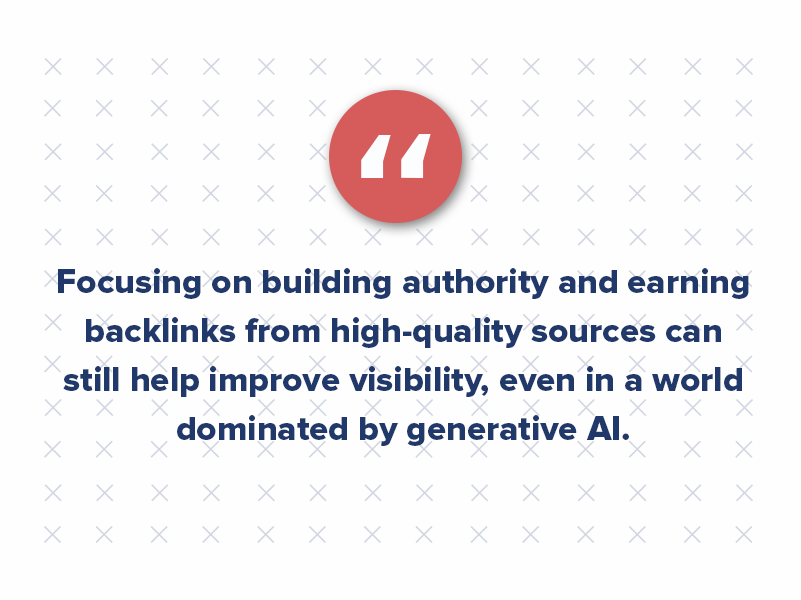How AI-Powered Search Features Are Reshaping SEO
What if the way we’ve been optimizing content for years (by chasing featured snippets) was no longer the best way to capture attention on the web?
For years, “position zero,” the coveted featured snippet spot, was the holy grail for content marketers and SEO specialists. Landing your website at the top of the search results page was a surefire way to increase visibility, build credibility, and drive massive traffic.
But with the rise of AI-powered technologies, such as Google AI Overviews, it seems like that era is starting to fade.

We’ve entered a time where generative models and AI content are no longer just buzzwords but driving forces shaping how we access and consume information. Google’s shift to more comprehensive AI summaries, or AI overviews, has begun to disrupt the very foundation of featured snippets. These overviews aggregate and summarize content from multiple sources, offering users a broader view of the answer to their search queries directly in the search results, often reducing the need to click through to any website.
This shift has left many wondering: Are featured snippets dying? And if so, what does that mean for the future of SEO, content creation, and customer service in the digital space?
As we dive deeper into 2025, it’s clear that Google Search is evolving, and so must our strategies to ensure our websites stand out.
Google AI Overviews: The New Frontier of Search
Google AI Overviews result from natural language processing (NLP) advancements, which allow AI to understand and generate human-like responses. Powered by machine learning models, these AI summaries are designed to answer a user’s query that synthesizes information from multiple web pages, providing a more holistic overview than a traditional text-based featured snippet.
Where featured snippets pull a direct, brief quote from one source to answer a query, AI overviews go further by compiling data and presenting it in a more natural, comprehensive summary. Imagine searching “What is SEO?” on Google and being presented with a detailed paragraph summarizing SEO, its components, benefits, and modern strategies — all directly on the search results page. No need to click through to a website, because the answer is already there, neatly packaged and ready for consumption.

The underlying generative AI systems powering these overviews are trained on vast amounts of data, enabling them to “learn” the best way to present information. This technology creates realistic, human-like responses to queries and allows users to access detailed information without leaving Google Search. In other words, Google is improving at curating content directly from the web to provide instant, highly relevant answers.
How Google AI Overviews Are Impacting Featured Snippets
Featured snippets have long been a powerful tool in SEO, driving significant traffic by appearing at the top of search results. For years, businesses have worked tirelessly to optimize their content to earn that spot. However, AI-powered overviews are beginning to challenge this model. With AI overviews, Google can now provide more extensive answers in one place, effectively reducing the need for users to click on any links.
This shift is evident in the declining click-through rates (CTR) for featured snippets, as evidenced by a recent Google CTR study. As AI overviews rise, they take center stage, pushing featured snippets into the background. Instead of pulling a snippet from a single page, AI systems generate a more complete response by drawing from multiple sources, ensuring the user receives the most relevant and comprehensive answer.
For marketers, this change means the SEO game is evolving once again. Generative models reshape how information is presented, and ranking for a featured snippet isn’t the same as it used to be. With AI overviews rising to prominence, businesses must rethink their content strategies to stay visible and competitive in the Google Search results.
The Role of Generative AI and Large Language Models (LLMs)
It’s important to look at the role of generative AI and large language models (LLMs) to understand why AI overviews are becoming the norm. These technologies are designed to generate human-like content based on vast amounts of training data. Unlike traditional search algorithms that rely on keyword matching and content extraction, LLMs like OpenAI’s GPT models and Google’s BERT use deep learning to understand context, tone, and intent. This allows them to generate more sophisticated, accurate responses.
Their ability to synthesize information from multiple sources sets AI overviews apart from traditional featured snippets. A single snippet might pull a short excerpt from one webpage, but an AI overview aggregates insights from across the web, offering users a fuller picture. This type of AI content provides answers in a more dynamic, useful manner and can potentially change how users interact with search engines.
As Google AI continues evolving, we may see more nuanced answers and AI features integrated directly into the search results page.
How AI Overviews Impact SEO and Content Creation
For SEO professionals and content creators, the rise of AI overviews means the game is changing. The days of simply optimizing for featured snippets are fading, as the importance of generating AI-friendly content takes precedence. To adapt, businesses need to focus on crafting content that answers specific queries and provides in-depth, contextually relevant information that Google’s AI can use to generate summaries.

As Google AI Overviews become more prevalent, businesses must create structured and easy content for AI models to interpret. Clear headers, bullet points, and structured data will ensure that AI can properly index and use the information. Content that fully addresses specific questions is more likely to be selected for AI overviews and will have a better chance of appearing on the search results page.
The Declining Role of Featured Snippets: What Does It Mean for SEO?
So, does this mean that featured snippets are dead? Not exactly. While AI overviews are certainly making their mark, featured snippets are still valuable for SEO, especially for certain queries. However, the increased prominence of AI overviews means marketers can no longer rely solely on featured snippets to drive traffic. Instead, SEO strategies must evolve to optimize for AI-generated summaries and embrace the broader changes happening in the search landscape.
To adapt, businesses need to rethink their approach to content creation and prioritize creating long-form, comprehensive, and well-structured content that AI systems can easily process. Additionally, focusing on building authority and earning backlinks from high-quality sources can still help improve visibility, even in a world dominated by generative AI.

The Future of Featured Snippets and AI Overviews
The rise of AI overviews signals a shift in how information is consumed on the web, and it’s clear that the AI-powered future of search is already here. Featured snippets aren’t going anywhere, but their role will evolve as AI technology improves. The key for businesses is to adapt to this new reality by optimizing for traditional snippets and AI-driven features.
Ultimately, the future of SEO is about creating high-quality, user-friendly content that aligns with search engine algorithms and AI models. As generative adversarial networks (GANs) and neural network technologies continue to advance, the way we approach content and search will evolve.
What’s Next for SEO? Embrace the AI Shift
As we look to the future of SEO and content creation, it’s clear that Google AI Overviews are not just a passing trend; they’re a fundamental shift in how search engines will deliver information.
The next SEO phase will involve optimizing AI content, focusing on depth, relevance, and clarity while adapting to an AI-driven search ecosystem. Businesses that can harness the power of generative AI, fine-tuning their content to match AI needs, will be best positioned to thrive in this new digital age.
When AI-driven summaries are becoming the norm, the question is: how will you adapt your content strategy to stay visible on the evolving search results page? The time to embrace this shift is now.





